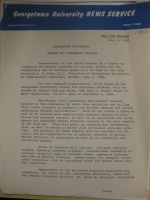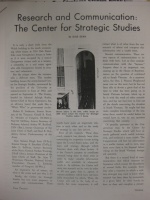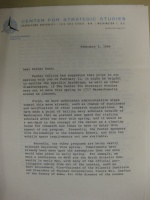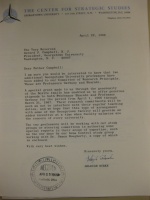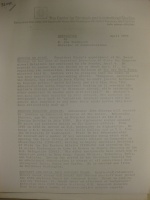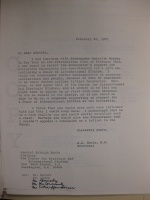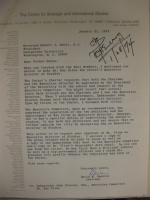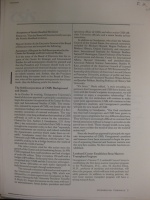Center for Strategic and International Studies, timeline
Revision as of 16:53, 16 March 2016 by Richard Bew (talk | contribs)
This timeline records key events in the history of the CSIS, in particular from the period of its creation until it was removed from campus at Georgetown University in 1986.
1962
June
- The announcement of the establishment of The Centre for Strategic (and International) Studies was made by Reverend E.B Bunn, President of Georgetown University on June 4 1962. It's stated aim was 'to coordinate and conduct studies related to the strategies by which free societies can utilise their total strength to preserve and further develop the values underlying Western civilisation.'
- Donald Sheehan of the University of Pennsylvania writes to Reverend Bunn, expressing that he was 'impressed with the need for such an independent objective agency' and that 'a university provides an ideal setting for such an organisation as you have envisioned'.
1963
February
- Courier article dated February 1963, outlining CSIS' contribution to coordinating research and facilitating meetings between strategists and other key political actors.
1964
February
- Arleigh Burke writes to Father Campbell regarding CSIS' move of headquarters to 1717 Massachusetts Avenue, away from Georgetown University Campus.
September
- Response to Admiral Burke from Father Campbell regarding constitutional restructuring of CSIS and the Board of Director's approval.
1966
April
- Letter from Admiral Burke regarding a grant from the Scaife Family Foundation to help retain Professors Garbuny and Sharabi from Georgetown.
September
- Admiral Burke writes to the CEO of the Automobile Manufacturers Association, asking that he sit as a member of the Executive Board.
1968
April
- The Research Council is created under the chairmanship of Professor Mosely to meet for the first time on 1 November 1968.
December
- Letter from Arleigh Burke to Father Campbell regarding the centre's name change from the Centre for Strategic Studies to the 'Centre for Strategic and International Studies' (CSIS). Father Campbell felt it important that the centre emphasise it's international focus alongside that of strategy.
1969
August
- Notification of CSIS constitutional changes to President Henle. Denotes name change to 'Centre for Strategic and International Studies', change of directorship to 'Chairman' to imply administrative role and central role of the Research Council in directing research,which replaced the Research Committee.
1970
April
- Newsletter of April 1970, confirming David Abshire's appointment by President Nixon to 'Assistant Secretary of State for Congressional Relations'. The role was designed to use Abshire's expertise to focus on the growing role of Congress in the formation of foreign policy.
- The newsletter also confirms the replacement of Abshire by Ambassador John Steeves as Executive Director of CSIS.
1971
February
- President of Georgetown Roger Henle writes to Admiral Burke regarding a meeting with Ambassador Spruille Braden and the gifting of a Chair of International Affairs to the university.
1974
January
- Letter from David Abshire to Father Henle regarding the separation of CSIS Chairman and Executive Director and appointment of former CIA operative Ray Cline to Executive Director of Studies.
1986
October
- Letter from Tim Healy to Stanley Katz taking on board the recommendation of a separate incorporation of CSIS stating that 'we are proceeding to an orderly separation' and that he hopes 'to avoid any claims of rancour or displeasure.'
November
- Confirmation of the separate incorporation decision made by the Board. General Andrew Goodpaster, who sat on the committee of external evaluators, argued that independently both Georgetown University and CSIS can 'embellish the characteristic activities which make them so valuable.' The five-member committee of external evaluators was made up of Sir Michael Howard, Samuel P. Huntington, Stanley Katz and Jaroslav Pelikan, as well as Goodpaster himself.
